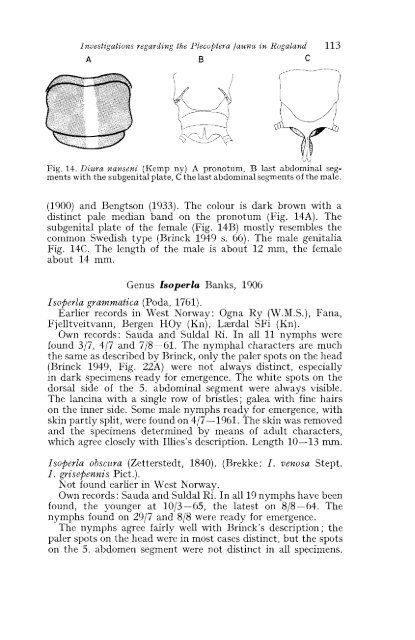NORSK ENTOMOLOGISK TIDSSKRIFT - Norsk entomologisk forening
NORSK ENTOMOLOGISK TIDSSKRIFT - Norsk entomologisk forening
NORSK ENTOMOLOGISK TIDSSKRIFT - Norsk entomologisk forening
You also want an ePaper? Increase the reach of your titles
YUMPU automatically turns print PDFs into web optimized ePapers that Google loves.
cu<br />
Investigations regarding the Plecoptera fauna in Rogaland 113<br />
L/<br />
A B C<br />
,-<br />
L+ $:/&c\<br />
'X' "L<br />
Fig. 14. Diz~ra nanseni (ICemp ny) A pronotum, B last abdominal segments<br />
with the subgenital plate, C the last abdominal segments of the male.<br />
(1900) and Bengtson (1933). The colour is dark brown with a<br />
distinct pale median band on the pronotum (Fig. 14A). The<br />
subgenital plate of the female (Fig. 14B) mostly resembles the<br />
comnlon Swedish type (Rrinck 1949 s. 66). The male genitalia<br />
Fig. 14C. The length of the male is about 12 mm, the female<br />
about 14 mm.<br />
Genus Isoperla Banks, 1906<br />
Iso$erla gramnzatica (Poda, 1761).<br />
Earlier records in West Norway: Ogna Ry (W.M.S.), Fana,<br />
Fjelltveitvann, Bergen HOy (Kn), Lzrdal SFi (Kn).<br />
Own records: Sauda and Suldal Ri. In all 11 nymphs were<br />
found 317, 417 and 7/8-61. The nymphal characters are much<br />
the same as described by Brinck, only the paler spots on the head<br />
(Brinck 1949, Fig. 22A) were not always distinct, especially<br />
in dark specimens ready for emergence. The white spots on the<br />
dorsal side of the 5. abdominal segment were always visible.<br />
The lancina with a single row of bristles; galea with fine hairs<br />
on the inner side. Some male nymphs ready for emergence, with<br />
skin partly split, were found on 4/7-1961. The skin was removed<br />
and the specimens determined by means of adult characters,<br />
which agree closely with Illies's description. Length 10-13 mm.<br />
Isofierla obsczlra (Zetterstedt, 1840). (Brekke: I. venosa Stept.<br />
I. grisefi~nnis Pict.).<br />
Not found earlier in West Norway.<br />
Own records: Sauda and Suldal Ri. In all 19 nymphs have been<br />
found, the younger at 1013-65, the latest on 8/8-64. The<br />
nymphs found on 2917 and 818 were ready for emergence.<br />
The nymphs agree fairly well with Brinck's description; the<br />
paler spots on the head were in most cases distinct, but the spots<br />
on the 5. abdomen segment were not distinct in all specimens.

















